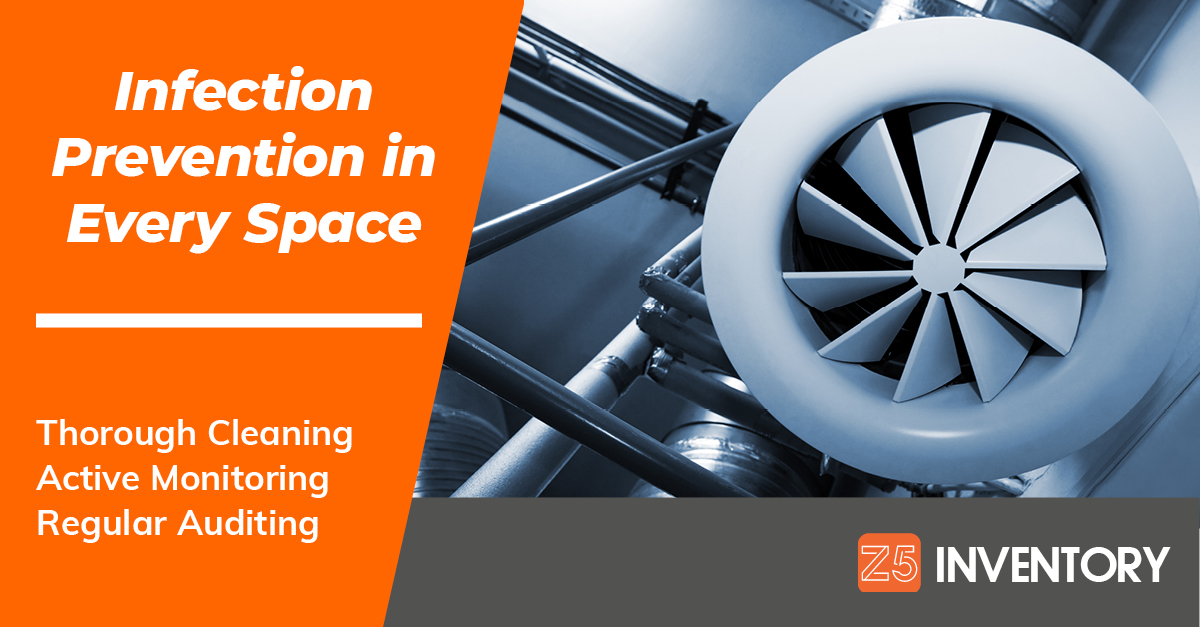The Importance Of Infection Prevention in Every Facility

Over the last few weeks we've been collecting advice from experts about what organizations - from hospitals to offices to schools - should be doing to prevent the spread of infection.
Dr. Jennifer Wagner and Damon Greeley from Onsite-LLC joined us on our podcast and video series, Take 5, which you can hear and download below. We combined the solid, step-by-step instructions that they provided, along with more we learned from their website and off-mic, to create this guide to keeping your spaces safe.
And "keeping" is the key word. Because - as we found out - it's not enough to get them ready to host employees, customers, visitors, and patients.
Cleaning Is A Good First Step
Of course you have to clean first. You have to make sure that your facility is up to code, especially if there are a bunch of codes you need to adhere to.
OSHA, ASHRAE, local versions of those organizations, and dozens of others offer a great starting point. Meeting their standards for cleanliness and stability of environment - which could and does vary widely from a loading dock to an operating room and everywhere in-between - is the literal minimum that you should expect to meet.
(And, it's worth saying, it's the minimum you should demand from those who are in charge of where you work. Some of the steps outlined by Onsite are able to be implemented by anyone in their own workspaces. But some will only be available to facilities supervisors, building owners, and others. So it's up to you to advocate for yourself - ideally by consulting those who control access where you work, but also contacting organizations like OSHA if necessary. If that ruffles feathers, too bad. It's for the sake of your - and your coworkers and your customers' - safety.)
But making sure that your facilities aren't set up to endanger you from the beginning - often in ways that you might not expect, like buildup in water pipes that have been left unused for an extended period - isn't the end goal.
Monitor Your Space During Activity
The only way you're going to get effective protection against infection is to monitor your spaces on an ongoing and regular basis.
Less-good-news first: you can't rely on an ideal scenario all the time. You can't just measure the makeup of air quality right after cleaning and before anyone reenters the space. You have to monitor the space constantly to see how human interaction affects its makeup.
If you're measuring office air humidity, for example, you might achieve an ideal percentage when the space is empty. But that doesn't help the person who's supposed to be working in that office every day. How do they change the air patterns and, therefore, the flow of potential contaminants? How do the people in the next office over, who share central air conditioning, change the air patterns? Are the air filters currently installed enough to prevent any cross-contamination? Are there air filters installed at all?
Ask yourselves all those questions again, imagining it isn't an office but an OR. See if that affects how seriously you take the questions. And, imagining there's just as serious a risk of infection passing between ORs as there is between offices - thanks, COVID-19 - and consider them all over again.
So what's the good-good news? Some of this - a lot of it, actually - can be automated. Following an assessment of your spaces and establishing a baseline for what humidity levels ought to be, you can set up sensors to monitor the level of humidity and alert you when readings veer too far from normal. And some of the tests you can implement on the spot will give you results within minutes, if not seconds, so there's no waiting for weeks to find out if you're within compliance.
There's one other instant way to ensure you're complying with all appropriate guidelines, too.
Get Someone Else To Monitor You
But don't take your own word for it. Get someone to audit you.
Whether that's as simple as having someone from down the hall come and double-check your results, or as complex as hiring an outside organization like OnSite to grade your success and provide improvement suggestions, you can't trust yourself - or just one facilities manager or head of OR - to be 100% right 100% of the time.
We don't trust ourselves to be right all the time. That's why we seek out expert help.
Continue listening to our expert interviews in Take 5: An Inventory Series. Thanks to Dr. Jennifer Wagner and Damon Greeley from Onsite-LLC for talking to us about something so important, yet so far out of our expertise. We've got more expertise coming from people like Hays Waldrop of the Council of Supply Chain Executives and others.
As always, every episode is a very manageable (and very on-brand) five minutes long. So you can pack a lot of great advice into a lunch break or a drive home or a walk you take just to get out of the damn house.
Oh, no. Now you're thinking about monitoring air patterns in your house.
Sorry about that.
